A Capabilities-Led Approach to Assessing Technological Solutions for a Rural Community
Abstract
1. Introduction
2. Background of the Case Study Area
3. Materials and Methods
3.1. Capabilities Approach
3.2. Data Collection and Analysis Methods
4. Results from the Focus Groups
4.1. Health
“Over the passing of time, the smoke is harmful to our health, because when we light the firewood we inhale the smoke, if we are near it and we are breathing it. It doesn’t affect you at first, but through time it damages our lungs and our eyes.”(Younger women’s group)
“When there is no water, even the dishes are washed with [water from the wells]. And because the wells are in open places, the wells are contaminated… [The animals] do their needs. We step on them and we contaminate the water without wanting to. If we had energy, all that could be avoided.”(Younger men’s group)
“I had a brother who suffered diabetes and had to take his insulin, he had to buy his ice and keep it in a thermos, so that the ice lasted at least 2 days.”(Younger men’s group)
“In an emergency, we are afraid to go out at night, because it’s dark and we feel as if something or someone is there.”(Younger women’s group)
“[The health centre] do not have [enough energy]. There are times when electric power goes almost 12 h, in rainy season we suffer more energy [cuts] throughout the town. The health centre suffers the consequences.”(Older men’s group)
4.2. Safety and Security
“It generates a problem of insecurity because it is dark. You do not know at what moment an animal or someone who is dedicated to making [trouble] is going to come out, or what is going to throw you”.(Younger men’s group)
“When it’s the rainy season we can’t go because it’s too wet, and the road it’s pretty bad, and we can fall, so that’s why we don’t go out to get [the firewood].”(Younger women’s group)
4.3. Making a Living
“If we had energy, we would be better and could compete with several states to be the best in the commercialization… for example, machine products and that all have to be of the same size. In our case, we cannot compete and we cannot sell to large companies like Wal-Mart, for example…if you take to Wal-Mart a thousand pieces and 300 of one size, 200 of another size and the rest of other sizes, they return the merchandise… because everything that is made by hand, it will never be the same, and what is done by machine is the same.”(Younger men’s group)
“The space where they sell, for example, everything we consume closes early because they do not have lighting, like the market, … the little square. If there were energy … they would close later because they have power. Because where they sell their products, …they do not have lighting due to lack of energy.”(Younger men’s group)
“Sometimes, due to lack of energy, we do not have internet. […] If we had internet, we were connected with all the people and in this way, we promote everything that is done here so that it could be commercialized, so that people could somehow sell their products.”(Younger men’s group)
“And if we want to open a business, we would have to use lots of appliances.”(Younger women’s group)
4.4. Education and Religious Practice
“It affects us because as you say, to do homework we have to be there with a candle.”(Younger men’s group)
“On the cell phone we have PDF virtual books and then, [the electricity cut] sometimes prevents our learning…we cannot see the virtual book and we delay in learning.”(Younger men’s group)
“In the churches, they also limit themselves lighting up the lights they have because then the bills are very expensive. And in the three churches and in the other churches that are in the community, the courtyards are dark in the evenings because of the lack of energy.”(Younger men’s group)
4.5. Relationships with Others
“Sometimes when we go to the hill to get the firewood, we do other chores, and then at night if we had more light we could go visit my dad, for example. I live around here, and my dad lives on the other side of town and is a little far…we can’t go out because of the same thing. It is too dark”.(Older women’s group)
“Obviously the antenna needs to be there due to lack of energy, where there is signal, there are wires. [If] we had energy, we could move [the antenna] to another place…but for lack of energy it has to be there, because if we move it higher or lower, there are no electricity cables.”(Younger men’s group)
“Here we celebrate the day of the dead and we make a gathering, and we could not make it because the electricity went off. Everyone was disappointed. Some had to blend the salsa, and here we grind the nixtamal with electricity.”(Older women’s group)
“Here, in my case, we are six people in the house, and I have to reuse the clothes so that I don’t have to wash too often. When there is a water shortage we go to the hill and there is a lagoon, despite it is very dirty, we wash them there.”(Older women’s group)
4.6. Other Basic Capabilities
“If there was an opportunity with the electric light we would no longer use the wood. That would prevent cutting of the trees, and with that we would avoid deforestation.”(Younger men’s group)
“If we had energy, we would also use it for example, doing planting grounds in the houses because we would already have water, to plant everything that we consume. For example, radishes, onions, chilies, would be planted with pumping water, because we have energy.”(Younger men’s group)
4.7. Barriers for Capabilities
4.7.1. Cost of Electricity and Water
“If I know that, in my house, the energy was cheaper, then I could buy an iron, a microwave, or, I don’t know. Then we have more confidence, we could buy more. Now it is difficult and we limit ourselves in everything. We need to see the way to see how those devices are ordered.”(Older men’s group)
“When we wanted to buy an electric stove, they [their husbands] told us that is too expensive, and this and that… ‘if you want to, you can read it on the packaging that comes with the stove it is written that it uses a lot of energy, and then, can you imagine to cook this or that’”(Older women’s group)
“I have a [gas] stove too but, … I feel that gas is too expensive. Sometimes they come to sell, two hundred pesos, and sometimes I buy but rarely, not always. I better use the firewood, because the gas is expensive.”(Younger women’s group)
“We are a low-income community, and not everyone pays the water bill. Many people owe on the water bill, and the company shuts the water supply for everyone.”(Younger women’s group)
4.7.2. Reliability and Security of Electricity Supply
“There are times when electric power goes almost 12 h. Rainy season is when we suffer more energy throughout the town. The health centre suffers the consequences.”(Older men’s group)
4.8. Overall Capability Assessment
5. Technology and Project Options for Delivering Energy Services
5.1. Solar Resource in Tlamacazapa
5.2. Option A: Providing Electricity for Street lighting
5.3. Option B: Supplying Power to Community Buildings—Schools, Health Centre and Churches
5.4. Option C: Clean Cooking with Renewable Generated Electricity
6. Discussion and Conclusions
Author Contributions
Funding
Institutional Review Board Statement
Informed Consent Statement
Data Availability Statement
Acknowledgments
Conflicts of Interest
References
- IRENA. Trends in Renewable Energy Database. Available online: https://public.tableau.com/views/IRENARETimeSeries/Charts?:embed=y&:showVizHome=no&publish=yes&:toolbar=no (accessed on 29 November 2020).
- ESMAP. Energy Storage Programme. Available online: https://www.esmap.org/energystorage (accessed on 28 November 2020).
- Huacuz, J.M.; Flores, R.; Agredano, J.; Munguia, G. Field performance of lead-acid batteries in photovoltaic rural electrification kits. Sol. Energy 1995, 55, 287–299. [Google Scholar] [CrossRef]
- Azimoh, C.L.; Wallin, F.; Klintenberg, P.; Karlsson, B. An assessment of unforeseen losses resulting from inappro-priate use of solar home systems in South Africa. Appl. Energy 2014, 136, 336–346. [Google Scholar] [CrossRef]
- Hansen, U.E.; Nygaard, I.; Maso, M.D. The dark side of the sun: Solar e-waste and environmental upgrading in the off-grid solar PV value chain. Ind. Innov. 2021, 28, 58–78. [Google Scholar] [CrossRef]
- Akinyele, D.O.; Rayudu, R.K.; Nair, N.K.C. Development of photovoltaic power plant for remote residential applications: The socio-technical and economic perspectives. Appl. Energy 2015, 155, 131–149. [Google Scholar] [CrossRef]
- Day, R.; Walker, G.; Simcock, N. Conceptualising energy use and energy poverty using a capabilities framework. Energy Policy 2016, 93, 255–264. [Google Scholar] [CrossRef]
- Malakar, Y.; Day, R. Differences in firewood users’ and LPG users’ perceived relationships between cooking fuels and women’s multidimensional well-being in rural India. Nat. Energy 2020, 5, 1022–1031. [Google Scholar] [CrossRef]
- Velasco-Herrejon, P.; Bauwens, T. Energy justice from the bottom up: A capability approach to community acceptance of wind energy in Mexico. Energy Res. Soc. Sci. 2020, 70, 101711. [Google Scholar] [CrossRef]
- Fernández-Baldor, Á.; Boni, A.; Lillo, P.; Hueso, A. Are technological projects reducing social inequalities and improving people’s well-being? A capability approach analysis of renewable energy-based electrification projects in Cajamarca, Peru. J. Hum. Dev. Capab. 2014, 15, 13–27. [Google Scholar]
- Cole, P. Assessing the impact of a renewable energy programme in Bamyan, Afghanistan: The value of a capability approach. Energy Sustain. Dev. 2018, 45, 198–205. [Google Scholar] [CrossRef]
- Malakar, Y. Evaluating the role of rural electrification in expanding people’s capabilities in India. Energy Policy 2018, 114, 492–498. [Google Scholar] [CrossRef]
- Arnaiz, M.; Cochrane, T.; Hastie, R.; Bellen, C. Micro-hydropower impact on communities’ livelihood analysed with the capability approach. Energy Sustain. Dev. 2018, 45, 206–210. [Google Scholar] [CrossRef]
- Nuestro México. Tlamacazapa Guerrero. Recuperado el 13 de 07 de 2018, de Nuestro México. Available online: http://www.nuestro-mexico.com/Guerrero/Taxco-de-Alarcon/Tlamacazapa/ (accessed on 14 April 2020).
- Wenman, C. Water Source, Use and Cost in a Context of Poverty: A Case Study of Tlamacazapa, Guerrero, Mexico. Master’s Thesis, The University of British Columbia, Vancouver, BC, Canada, 2012. [Google Scholar]
- Foro-Mexico. Información de Tlamacazapa (Taxco de Alarcón). Available online: https://www.foro-mexico.com/guerrero/tlamacazapa/mensaje-183862.html (accessed on 11 December 2020).
- Smith, S.E.; Marin, L.E. Water and the rural poor in Latin America: The case of Tlamacazapa, Guerrero, Mexico. Hydrogeol. J. 2005, 13, 346–349. [Google Scholar] [CrossRef]
- Bartiaux, F.; Vandeschrick, C.; Moezzi, M.; Frogneux, N. Energy justice, unequal access to affordable warmth, and capability deprivation: A quantitative analysis for Belgium. Appl. Energy 2018, 225, 1219–1233. [Google Scholar] [CrossRef]
- Sen, A. Inequality Re-examined; Harvard University Press: Cambridge MA, USA, 1992. [Google Scholar]
- Sen, A. Development as Freedom; Oxford University Press: Oxford, UK, 1999. [Google Scholar]
- Nussbaum, M.C. Creating Capabilities: The Human Development Approach and Its Implementation. Hypatia 2008, 24, 211–215. [Google Scholar] [CrossRef]
- Deneulin, S. Perfectionism, paternalism and liberalism in Sen and Nussbaum’s Capability Approach. Rev. Political Econ. 2002, 14, 497–518. [Google Scholar] [CrossRef]
- IRENA. Electricity Storage and Renewables: Costs and Markets to 2030; International Renewable Energy Agency: Abu Dhabi, United Arab Emirates, 2017.
- IRENA. Renewable Power Generation Costs in 2019; International Renewable Energy Agency: Abu Dhabi, United Arab Emirates, 2020.
- IEA. Lighting; IEA: Paris, France. Available online: https://www.iea.org/reports/lighting (accessed on 21 December 2020).
- Meier, P.; Vagliasindi, M.; Imran, M.; Eberhard, A.; Siyambalapitiya, T. The Design and Sustainability of Renewable Energy Incentives: An Economic Analysis. Directions in Development—Energy and Mining; World Bank: Washington, DC, USA, 2015. [Google Scholar]
- Global Solar Atlas. Tlamacazapa. Available online: https://globalsolaratlas.info/map?c=11.523088,8.4375,3 (accessed on 14 December 2020).
- Jordan, M.; Corry, J.; Jacques, I. Energy efficiency: A Key Enabler for Energy Access. International Bank for Reconstruction and Development; The World Bank: Washington, DC, USA, 2017. [Google Scholar]
- Duman, A.C.; Güler, Ö. Techno-economic analysis of off-grid photovoltaic LED road lighting systems: A case study for northern, central and southern regions of Turkey. Build. Environ. 2019, 156, 89–98. [Google Scholar] [CrossRef]
- Wu, M.S.; Huang, H.H.; Huang, B.J.; Tang, C.W.; Cheng, C.W. Economic feasibility of solar powered led road-way lighting Renew. Energy 2009, 34, 1934–1938. [Google Scholar]
- Velaga, R.; Kumar, A. Techno-economic evaluation of the feasibility of a smart street system: A case study of rural India. Procedia Soc. Behav. Sci. 2012, 62, 1220–1224. [Google Scholar] [CrossRef]
- Ciriminna, R.; Meneguzzo, F.; Albanese, L.; Pagliaro, M. Solar street lighting: A key technology en route to sustainability. Wiley Interdiscip. Rev. Energy Environ. 2016, 6, e218. [Google Scholar] [CrossRef]
- Babatunde, M.O.; Akinbulire, T.O.; Oluseyi, P.O.; Emezirinwune, M.U. Techno-economic viability of off-grid standalone PV-powered LEP street lighting systems in Lagos, Nigeria. Afr. J. Sci. Technol. Innov. Dev. 2019, 11, 807–819. [Google Scholar] [CrossRef]
- Sutopo, W.; Mardikaningsih, I.S.; Zakaria, R.; Ali, A. A Model to Improve the Implementation Standards of Street Lighting Based on Solar Energy: A Case Study. Energies 2020, 13, 630. [Google Scholar] [CrossRef]
- Confidential quotation for solar light fixtures for Tlamacazapa, Mexico Project. UK, 2020; [Supplier X].
- Quak, E. The Costs and Benefits of Lighting and Electricity Services for Off-Grid Populations in Sub-Sahara Africa; K4D Helpdesk Report No. 317; Institute of Development Studies: Brighton, UK, 2018. Available online: https://assets.publishing.service.gov.uk/media/5af96657ed915d0df4e8cdea/Costs_Benefits_Off-Grid_Electricity_Lighting_Systems.pdf (accessed on 2 March 2021).
- Espejel-Blanco, D.F.; Hoyo-Montano, J.A.; Orrante-Sakanassi, J.A.; Federico-Rivera, J.A. Comparison of Energy Consumption of Fluorescent Vs LED Lighting System of an Academic Building. In Proceedings of the 2018 IEEE Conference on Technologies for Sustainability (SusTech), Long Beach, CA, USA, 11–13 November 2018; pp. 1–6. Available online: https://ieeexplore.ieee.org/document/8671348 (accessed on 2 March 2021).
- Energy Saving Trust. Is Home Energy Storage Right for me? Available online: https://energysavingtrust.org.uk/home-energy-storage-right-me/ (accessed on 28 November 2020).
- BloombergNEF. Lithium-Ion Battery Price Outlook. Available online: https://about.bnef.com/blog/behind-scenes-take-lithium-ion-battery-prices/ (accessed on 15 December 2020).
- Park, W.Y.; Shah, N.; Phadke, A. Enabling access to household refrigeration services through cost reductions from energy efficiency improvements. Energy Effic. 2019, 12, 1795–1819. [Google Scholar] [CrossRef]
- Putti, V.R.; Tsan, M.; Mehta, S.; Kammila, S. The State of the Global Clean and Improved Cooking Sector. ESMAP Technical Paper; No. 007/15 World Bank: Washington, DC, USA, 2015. [Google Scholar]
- World Health Organization. Burden of Disease from Household Air Pollution for 2012; World Health Organization: Geneva, Switzerland, 2014. [Google Scholar] [CrossRef]
- Hernández-Garduño, E.; Gómez-García, E.; Campos-Gómez, S. Prevalence trends of wood use as the main cooking fuel in Mexico, 1990–2013. Salud Pública México 2017, 59, 68–75. [Google Scholar] [CrossRef] [PubMed]
- Berrueta, V.M.; Serrano-Medrano, M.; García-Bustamante, C.; Astier, M.; Masera, O.R. Promoting sustainable local development of rural communities and mitigating climate change: The case of Mexico’s Patsari improved cookstove project. Clim. Chang. 2015, 140, 63–77. [Google Scholar] [CrossRef]
- Batchelor, S.; Brown, E.; Leary, J.; Scott, N.; Alsop, A.; Leach, M. Solar electric cooking in Africa: Where will the transition happen first? Energy Res. Soc. Sci. 2018, 40, 257–272. [Google Scholar] [CrossRef]
- ESMAP. Cooking with Electricity: A Cost Perspective. Energy Sector Management Assistance Program (ESMAP); World Bank: Washington, DC, USA, 2020.
- Leach, M.; Leary, J.; Scott, N.; Batchelor, S.; Chen, X.; Ng, K.-S.; Oduro, R.; Brown, E. eCook Modelling. November 2019 Working Paper. Available online: https://mecs.org.uk/wp-content/uploads/2019/11/eCook-model-Working-Paper-November-2019.pdf (accessed on 28 November 2020).
- Medina, P.; Berrueta, V.; Cinco, L.; Ruiz-García, V.; Edwards, R.; Olaya, B.; Schilmann, A.; Masera, O. Understanding Household Energy Transitions: From Evaluating Single Cookstoves to “Clean Stacking” Alternatives. Atmosphere 2019, 10, 693. [Google Scholar] [CrossRef]
- Armanios, D.E. Holistically representing women. Nat. Energy 2020, 5, 939–940. [Google Scholar] [CrossRef]
- Murrant, D.; Radcliffe, J. Assessing energy storage technology options using a multi-criteria decision analysis-based framework. Appl. Energy 2018, 231, 788–802. [Google Scholar] [CrossRef]

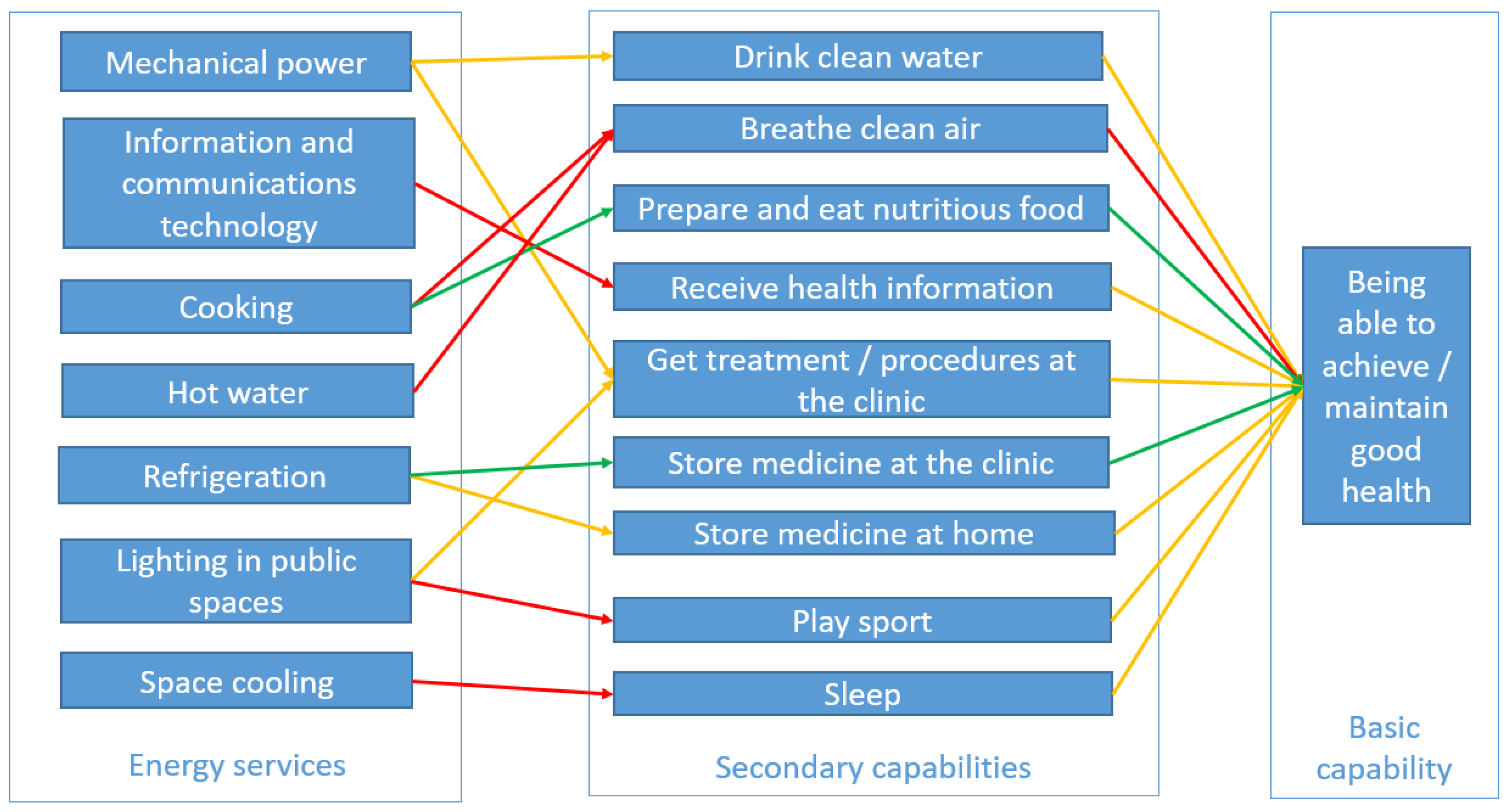

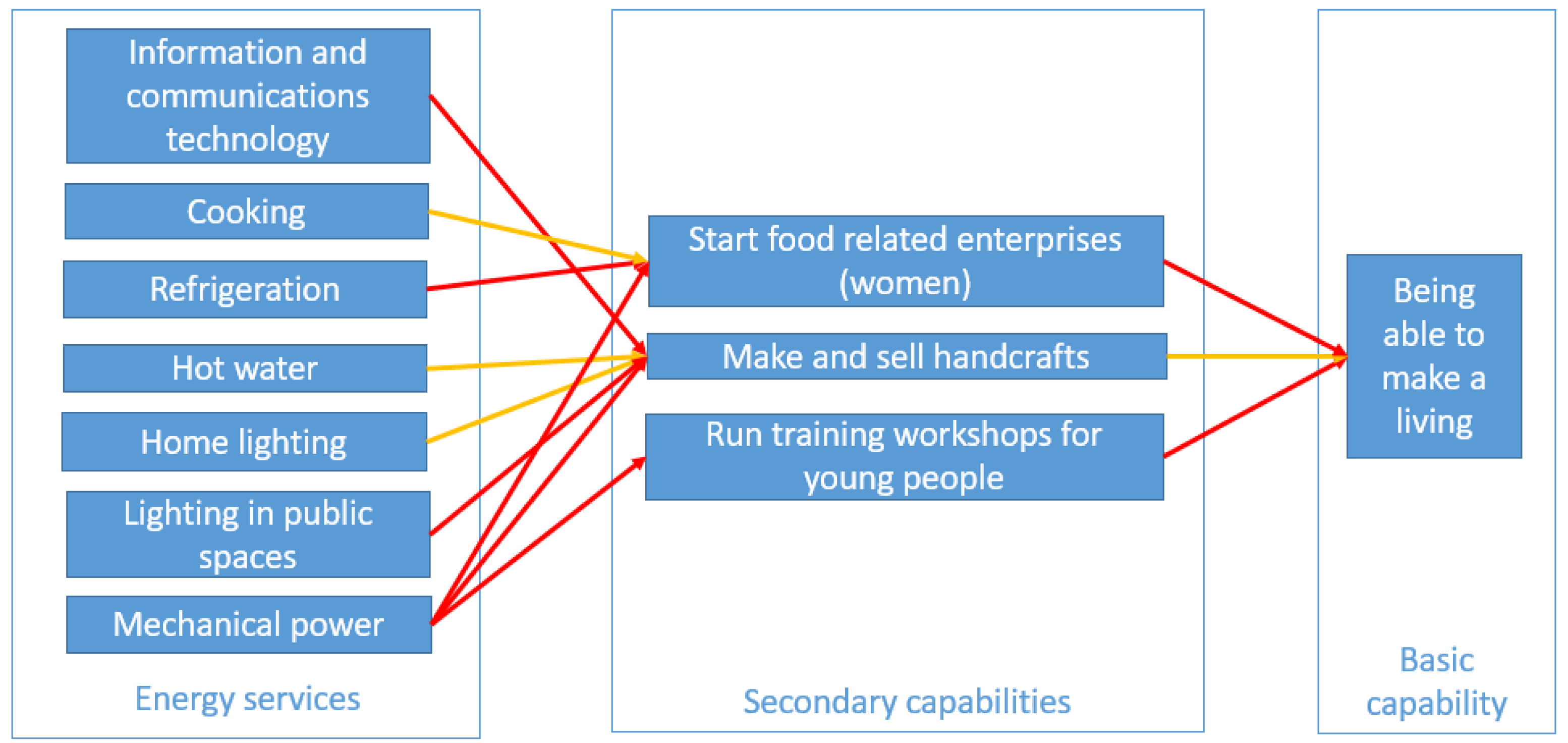
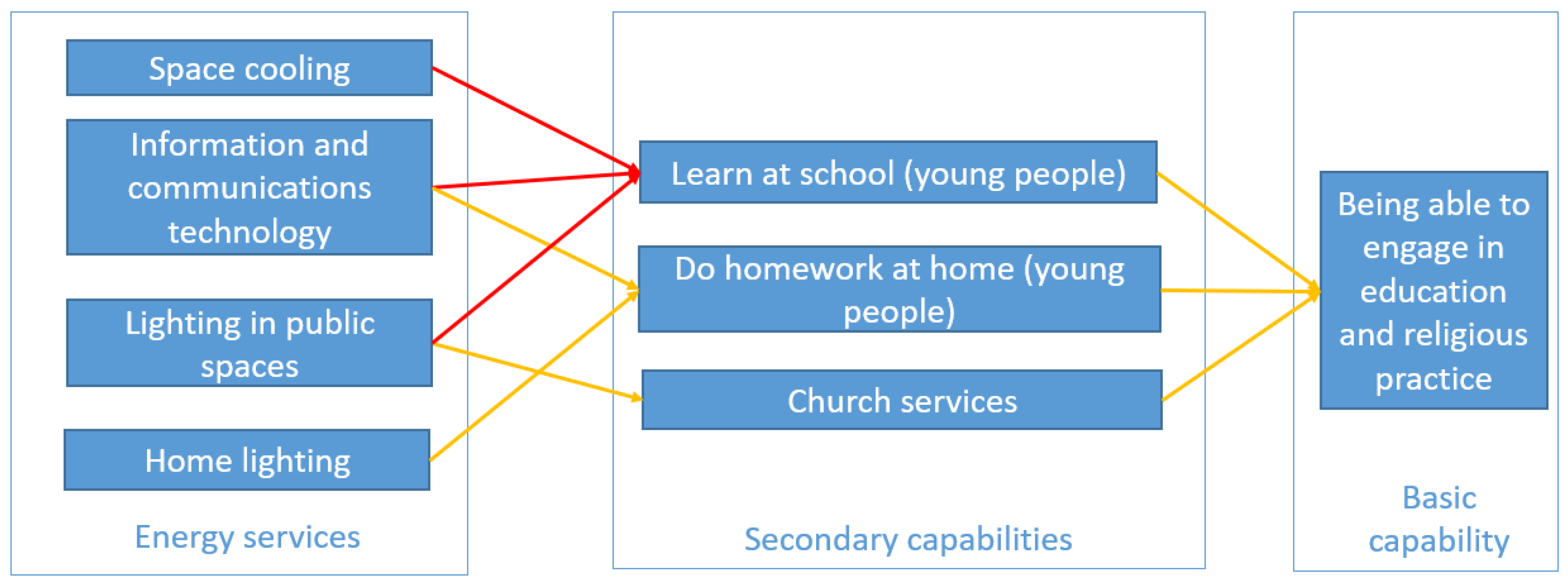
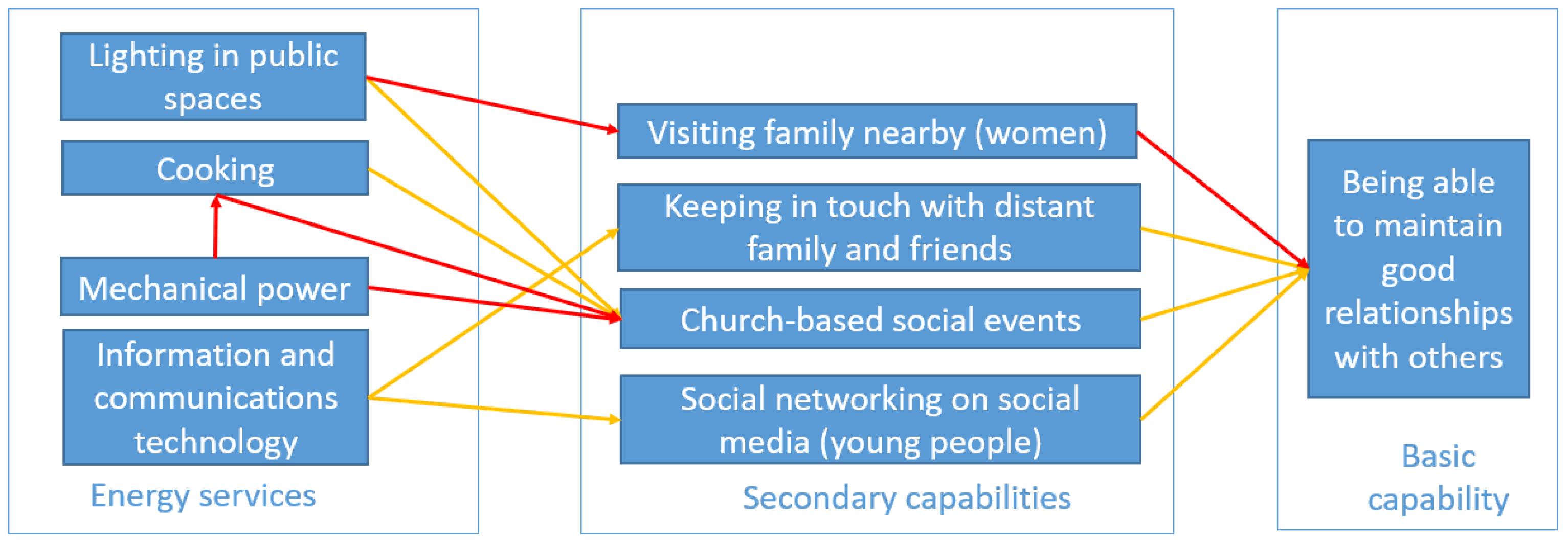
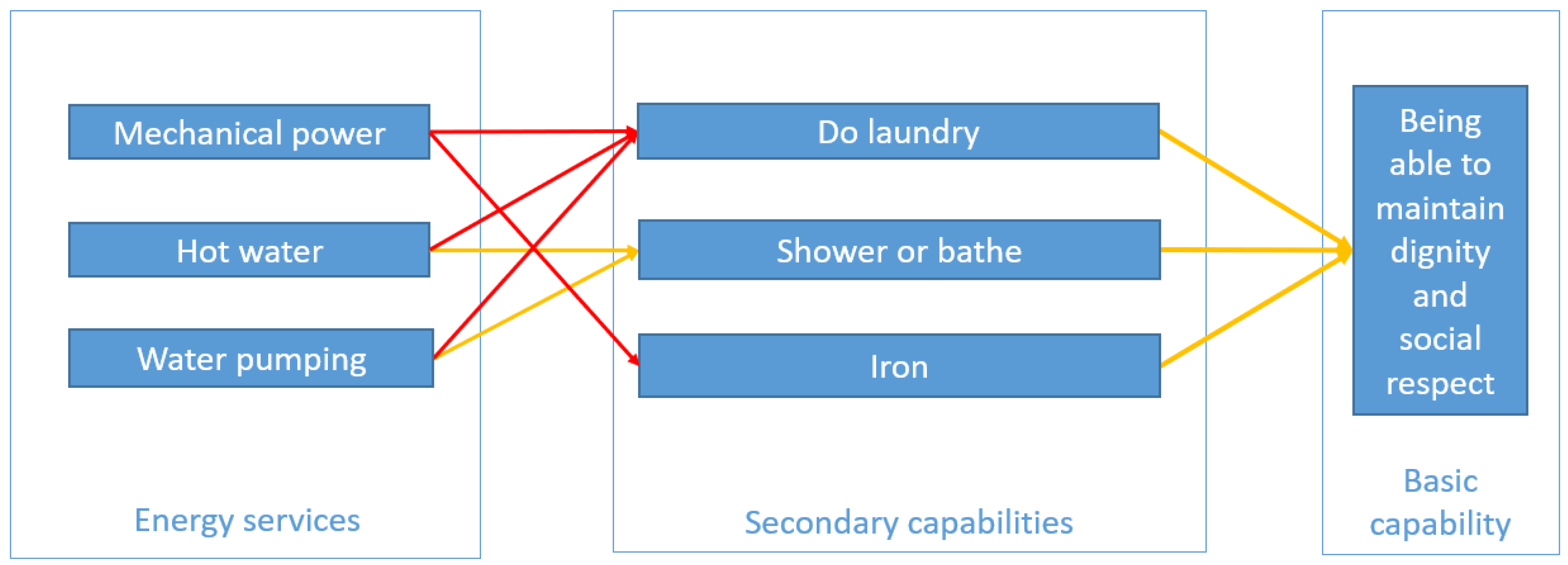


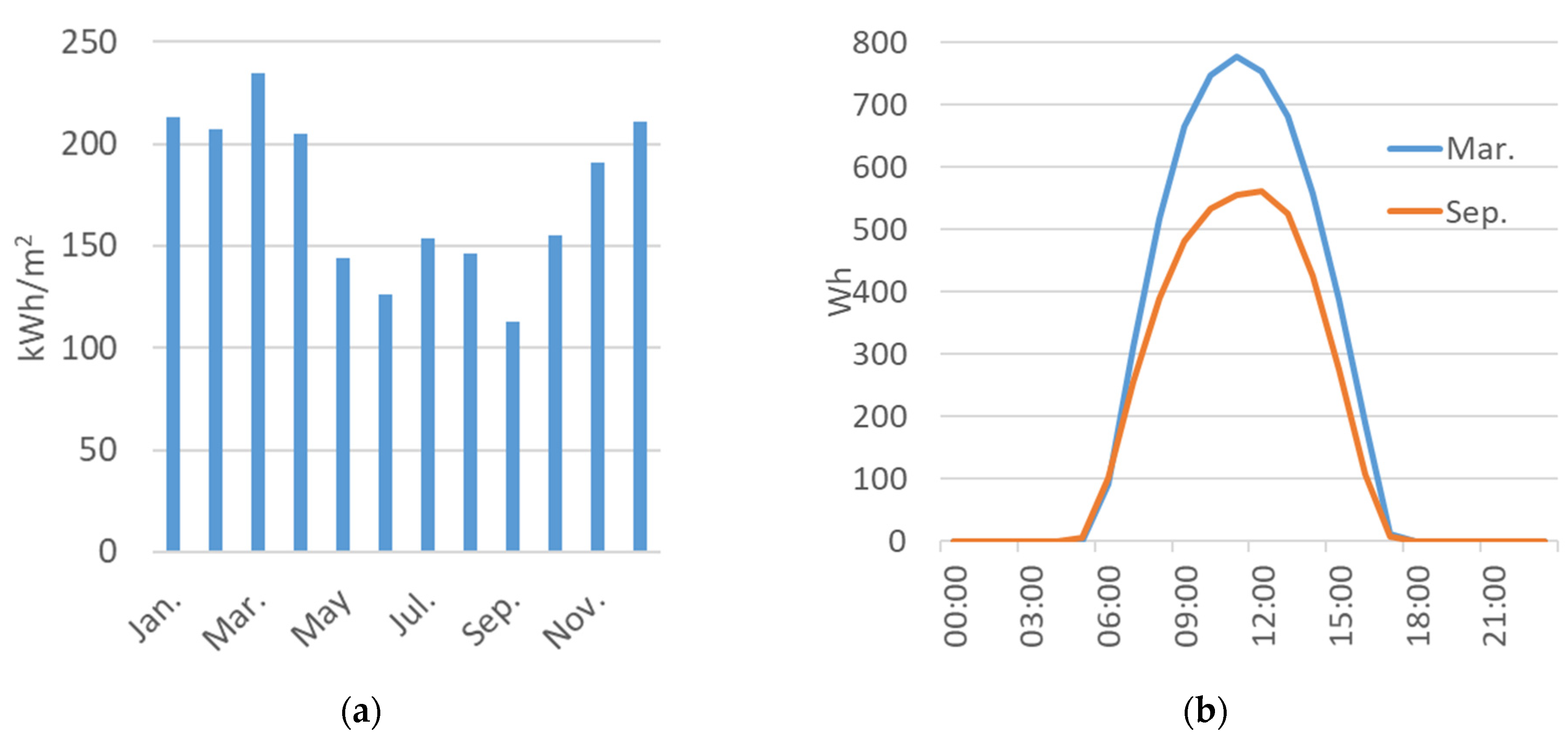
| Nussbaum’s List of Central Capabilities [21] | Capabilities Selected for Discussion in Relation to Energy Use |
|---|---|
| Life (being able to live to the end of a human life of normal length) | |
| Bodily health (being able to have good health) | Discussed in relation to clean air and water, nutrition, healthcare and sleep |
| Bodily integrity (being able to move freely from place to place) | Discussed in relation to safety and safe movement |
| Senses, imagination, and thought (being able to use the senses, to imagine and think) | Discussed in relation to education and religious practice |
| Emotions (being able to have attachments to things and people) | |
| Practical reason (being able to form a conception of the good) | |
| Affiliation (being able to live with and toward others; having the social bases of self-respect) | Discussed in relation to relationships with relatives and friends; dignity and self-respect |
| Other species (being able to live with concern for other species) | Discussed in relation to relationships with animals and nature |
| Play (being able to laugh and play) | Discussed in relation to recreation |
| Control over one’s environment (being able to work as a human; being able to participate effectively in political choices) | Discussed in relation to earning a living. Political participation excluded as too sensitive. |
| Energy Service | Secondary Capabilities | Energy Source or Fuel Options | ||
|---|---|---|---|---|
| Not Secured | Partly Secured | Secured | ||
| Lighting | 7 | 5 | - | Electricity |
| Mechanical | 5 | 3 | 1 | Liquid fuel/electricity |
| Cooking | 3 | 3 | 1 | Wood/gas/electricity |
| Hot water | 3 | 3 | - | Wood/gas/electricity |
| ICT | 3 | 3 | - | Electricity |
| Pumping | 2 | 1 | - | Liquid fuel/electricity |
| Cooling | 2 | - | - | Electricity |
| Refrigeration | 1 | 1 | 1 | Electricity |
Publisher’s Note: MDPI stays neutral with regard to jurisdictional claims in published maps and institutional affiliations. |
© 2021 by the authors. Licensee MDPI, Basel, Switzerland. This article is an open access article distributed under the terms and conditions of the Creative Commons Attribution (CC BY) license (http://creativecommons.org/licenses/by/4.0/).
Share and Cite
Wang, X.; Day, R.; Murrant, D.; Marín, A.D.; Botello, D.C.; González, F.L.; Radcliffe, J. A Capabilities-Led Approach to Assessing Technological Solutions for a Rural Community. Energies 2021, 14, 1398. https://doi.org/10.3390/en14051398
Wang X, Day R, Murrant D, Marín AD, Botello DC, González FL, Radcliffe J. A Capabilities-Led Approach to Assessing Technological Solutions for a Rural Community. Energies. 2021; 14(5):1398. https://doi.org/10.3390/en14051398
Chicago/Turabian StyleWang, Xinfang, Rosie Day, Dan Murrant, Antonio Diego Marín, David Castrejón Botello, Francisco López González, and Jonathan Radcliffe. 2021. "A Capabilities-Led Approach to Assessing Technological Solutions for a Rural Community" Energies 14, no. 5: 1398. https://doi.org/10.3390/en14051398
APA StyleWang, X., Day, R., Murrant, D., Marín, A. D., Botello, D. C., González, F. L., & Radcliffe, J. (2021). A Capabilities-Led Approach to Assessing Technological Solutions for a Rural Community. Energies, 14(5), 1398. https://doi.org/10.3390/en14051398







